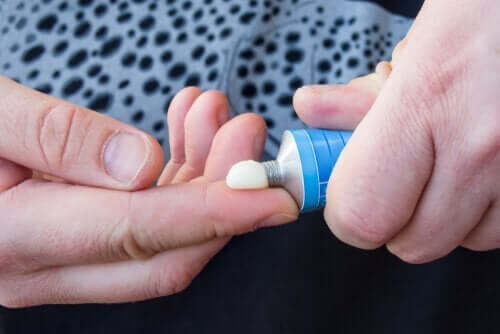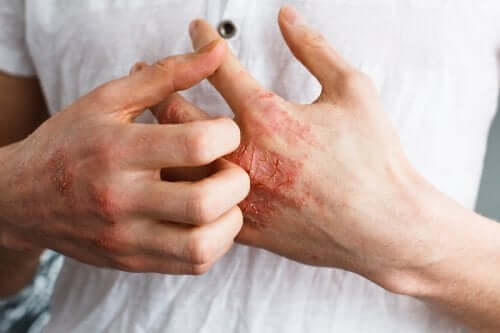Diproderm on Skin: Uses and Side Effects

Diproderm is the trade name of the active ingredient betamethasone dipropionate, used for the local treatment of the inflammatory manifestations of itchy skin.
It’s a drug that belongs to the family of corticoids and you administer it topically. In short, we use it to treat the following:
- Allergic contact dermatitis: acute forms of allergy to a substance that has come into contact with the skin.
- Allergic reactions to commonly used substances, as occurs in irritative contact dermatitis.
- Dyshidrotic numbness.
- Other types of dermatitis, such as atopic, neurodermatitis, seborrheic, or stasis dermatitis.
Moreover, doctors indicate diproderm to treat all these skin pathologies in adults and children over 12 years old.
What is betamethasone dipropionate or Diproderm?

As we’ve said, Diproderm is the trademark of betamethasone. This active ingredient is a steroid from the corticosteroid group that’s used in medicine due to its immunosuppressive and anti-inflammatory properties.
In addition, it has a distinct advantage over other corticosteroid medications: betamethasone doesn’t cause water retention.
Doctors can administer it in different pharmaceutical forms. In the case of Diproderm, it has been marketed in the form of a cream for topical administration, in order to relieve the following skin symptoms:
- Itching
- Redness
- Inflammation
You may want to read: Itchy Skin or Pruritus: Symptoms, Causes, and Recommendations
Basic concepts of dermatitis
Dermatitis is one of the most common skin conditions among the general population. This term is classified into different categories and it usually isn’t that easy to identify the type of dermatitis a patient is suffering from at first sight.
Depending on the factors, causes, and symptoms, one type of dermatitis or another will be diagnosed, and the treatment will vary depending on each type. Among the most common dermatitis, we can mention:
- Atopic dermatitis: a chronic condition. It usually appears during childhood with much dryness and itching of the skin. It usually occurs in the joints, buttocks, and cheeks.
- Dermatitis by contact: This usually affects adults. It appears due to a reaction that the skin suffers when in contact with an irritative substance.
- Seborrheic dermatitis: The most affected areas are those that contain more oil, such as the scalp, face or inside the ear.
- Stasis dermatitis: A skin change that occurs when blood collects in the veins of the lower leg. It usually causes poor circulation.
- Nummular dermatitis: The spots that appear on the skin are coin-shaped and appear mainly on the back of the extremities, the trunk and the buttocks. Winter is the most prone season, especially for patients with drier skin.
Discover: 8 Foods that Improve Your Skin Health
Adverse effects of Diproderm on skin

As with all medications, Diproderm can cause a number of adverse reactions that should be considered when starting treatment.
Specialists have reported the following adverse effects with the use of Diproderm, especially after prolonged application, over large areas, with bandages or occlusive materials:
- Skin atrophy
- Hematomas
- Erythremia
- Dryness or cracking of the skin
- Acne
- Hair growth
- Cutaneous stretch marks
- Contact dermatitis
- Infections
In addition, there are other, less frequent, adverse reactions that can develop with the use of Diproderm 0.5 mg/g skin solution. These are allergy and skin color changes.
It’s important to note that adverse effects can occur in other parts of the body, not just the treated areas. This usually happens when the active ingredient passes into the blood and spreads throughout the body.
Conclusion
Diproderm contains the corticoid betamethasone. Doctors primarily use it to treat itchy and inflamed skin conditions, such as those that develop in various dermatitis.
Treatments with corticosteroids, especially long-term treatments, shouldn’t be discontinued abruptly. In addition, you should always follow the doctor’s instructions and consult them or the pharmacist if you have any doubts. In conclusion, don’t self-medicate, your health depends on it!
All cited sources were thoroughly reviewed by our team to ensure their quality, reliability, currency, and validity. The bibliography of this article was considered reliable and of academic or scientific accuracy.
- Moreno, R. A., & Peiró, P. S. (2000). Atopic dermatitis. Medicina Naturista.
- Eriksen, K. (1979). Comparison of clobetasol propionate and betamethasone-17,21 dipropionate with reference to adrenal suppression. Acta Dermato-Venereologica.
- Azparren, A., Servicio, A., & Farmacéuticas, D. P. (2009). Corticoides tópicos. Boletín de Información Farmacoterapéutica de Navarra.
This text is provided for informational purposes only and does not replace consultation with a professional. If in doubt, consult your specialist.








